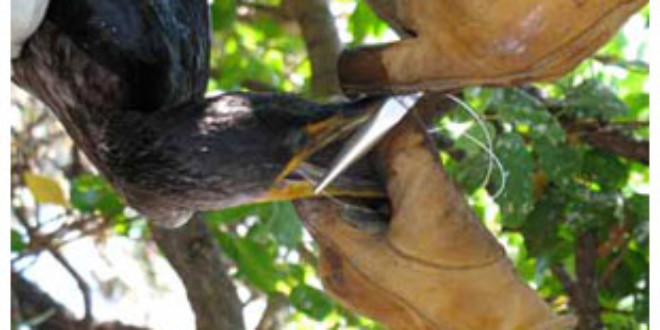(From tampa.creativeloafing.com) – Once Ann Hodgson brushes aside the leaves, the little white body isn”t hard to see. There, hanging from a mangrove branch, is the dried-out, desiccated body of a snowy egret. Wrapped around its neck is a thin piece of fishing line. “It apparently just hung to death,” says Hodgson, sanctuaries manager for Audubon of Florida.
On this crisp, cool day, Hodgson and biologist Mark Rachal have decided to tackle the (fishing) tackle in Dog Leg Key, a small mangrove island in Boca Ciega Bay near John’s Pass and War Veterans’ Memorial Park in St. Petersburg. The islet is a major nesting site for sea birds, including brown pelicans, snowy egrets, double-crested cormorants and great blue herons. The bird sanctuary, managed by Audubon, is off limits to the public. But that doesn’t stop some fishermen from casting their lines into the thick mangroves, hoping to snag a fish resting in the trees’ shadows.
“What happens is the fisherman will cast into the trees and, if they overcast, they can get their line entangled in the mangroves,” Hodgson says. “And so we have to cut it out of the mangroves and pull it out of trees.”
Hodgson and Rachal are taking part in an annual monofilament clean-up effort spearheaded by Audubon and Tampa Bay Watch, a nonprofit environmental stewardship program. Each October, in the birds’ off-nesting season, hundreds of volunteers fan out to Tampa Bay’s islands, keys and coastal areas, cutting fishing line snagged on trees, brush and, oftentimes, the birds themselves.
“We don’t get many rescues,” Rachal notes.
For the next few hours, Rachal and Hodgson fan out along Dog Leg Key with pliers and trash bags, looking up and under and through the mangrove trees, searching for fishing line. It’s not always easy to see.
“The monofilament is almost invisible when it’s wound inside the trees,” Hodgson explains. “It’s pretty easy for a bird walking through the tree tops … to step through these leaves and get their foot entangled.”
Last year, Hodgson and Rachal removed several trash bags full of monofilament line from Dog Leg Key, along with two pelicans and a dead snowy egret.
It was pretty obvious that the bird had gotten the fishing line wrapped around its feet and somehow got snagged to the tree, [clinging] to the branch until it just became too weak. … and then just finally keeled over,” Hodgson recalls. “We found it hanging upside down, still wired to the tree.”
Dead birds are not the exception; they’re the rule. At every monofilament clean-up site, volunteers find at least a few dead birds obviously strangled or caught by fishing line. During one outing, an Audubon biologist found 15 dead pelicans entangled in one strand of line.
“I think people come out for the day or weekend and they don’t understand the consequences of their actions when they leave out 300 feet of line,” says Rachal. “One piece can really wreak havoc.”
The biologists say the key to avoiding such tragic scenarios is to teach fishermen to avoid cutting line if it becomes entangled; pull any line out of trees and weeds; and dispose of it in monofilament tubes near boat ramps and not garbage cans.
Just as the two biologists finish combing the key, Rachal notices rustling in the mangroves. He parts the leaves to find a double-crested cormorant struggling to free itself. The black, long-necked sea bird has swallowed a hook and the other end of the line is caught on a branch. Rachal grabs the bird while Hodgson sticks her fingers in its mouth, trying to locate the hook. She explains the hook is already in its stomach, and the cormorant “can’t be operated on.”
“This is what happens when hooks and monofilament line is left on these bird colony islands or anywhere a bird can get to them,” Hodgson says gravely. “This bird is weakened and sick and is probably going to die.”
Reluctantly, they leave the bird. As they wade back to their boat, oyster shells crunching under their feet, the cormorant falls on its side, flapping its wings in vain.
(By Alex Pickett)
 Ocean Sentry
Ocean Sentry




